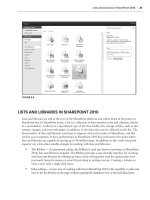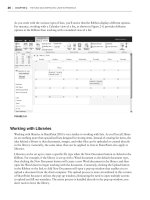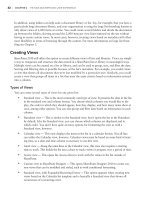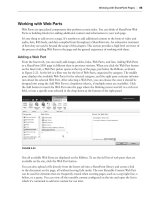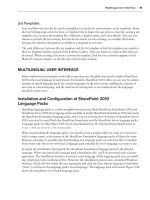Thủ thuật Sharepoint 2010 part 08 pps
Bạn đang xem bản rút gọn của tài liệu. Xem và tải ngay bản đầy đủ của tài liệu tại đây (525.72 KB, 7 trang )
Working with SharePoint Pages
❘
45
Working with Web Parts
Web Parts are specialized components that perform certain tasks. You can think of SharePoint Web
Parts as building blocks for adding additional content and information to your web page.
It’s one thing to add text to a page. It’s another to add additional content in the form of video and
audio, lists, RSS feeds, and data compiled from throughout a SharePoint site. An exhaustive treatment
of how they are used is beyond the scope of this chapter. This section provides a high-level overview of
the process of adding Web Parts to the page and the general experience of working with them.
Adding a Web Part
From the Insert tab, you can easily add images, tables, links, Web Parts, and lists. Adding Web Parts
to a SharePoint 2010 page is different than in previous versions. When you click the Web Part button
on the Insert tab, a Web Part picker opens at the top of the page, just below the Ribbon, as shown
in Figure 2-23. At the left is a filter tree for the list of Web Parts, organized by category. The middle
pane displays the available Web Parts for the selected category, and the right pane contains informa-
tion about the selected Web Part. After selecting a Web Part, you can choose the zone it should be
dropped into using the Add Web Part to: dropdown (that is, if multiple zones are available). Click
the Add button to insert the Web Part onto the page where the blinking cursor was left in a rich text
field, or into a specific zone selected in the drop-down at the bottom of the right panel.
FIGURE 223
Not all available Web Parts are displayed on the Ribbon. To see the full list of web parts that are
available on the site, click the Web Part button.
You can also upload a file directly from the Insert tab into a SharePoint library and create a link
to the document on the page, all without leaving Edit mode. The new Reusable Content Web Part
can be used for elements that are frequently reused when creating pages, such as a copyright line, a
byline, or a quote. You can view all the reusable content configured on the site and open the list in
which it’s contained to add new content for use later.
46
❘
CHAPTER 2 the NeW aNd imProved User exPerieNce
Another novel addition to the Ribbon is the capability to create a new list on the
fl y directly from the Ribbon using the New List button. A pop-up window will
open, from which you can choose your list template and give the list a name.
The newly created list will appear on the page.
Using the Ribbon to Work with Web Parts
When a Web Part is selected on the page, a new contextual tab opens in the Ribbon. Depending on
the Web Part selected, various options are available. For instance, inserting the new Media Web Part
(from the Media and Content category) will open both the Options tab under the Web Part Tools
header and another Options tab under the Media header (see Figure 2-24). The Media Web Part lets
you add a Silverlight media player to the page to play audio and video clips. As you might guess, the
Options tab under the Web Part Tools header contains options for working with the Web Part in
general (such as opening its properties or deleting it), whereas the Media heading’s Options tab per-
tains specifi cally to the selected Web Part. Not all Web Parts have a dedicated tab in the Ribbon, but
they all will open the Web Part Tools Options tab.
FIGURE 224
Many users familiar with older versions of SharePoint will also recognize the tool pane for working
with Web Parts. Clicking the Web Part Properties button in the Ribbon will open the familiar tool
pane along the right side of the screen, which contains options for working with the selected Web
Part. You can change the Web Part’s title and description and chrome state (whether its title and
border display), as well as other options specifi c to that Web Part.
Working with SharePoint Pages
❘
47
Overall, working with Web Parts in SharePoint 2010 isn’t very different from past versions. Some Web
Parts will have additional options in the tool pane depending on the type of Web Part. Figure 2-25 shows
the tool pane for the Shared Documents library Web Part. The Content Query Web Part, for example,
enables you to aggregate content from your site based on its content types. It has many different options
for configuring the query used to gather its content, something that other Web Parts do not need and
therefore do not feature. This tool pane can also be accessed from the Web Part’s drop-down menu,
which appears to the far right of the Web Part’s title. Click the drop-down arrow and select Edit
Web Part to open the tool pane.
FIGURE 225
A new option found on the tool pane for some Web Parts that wasn’t found in previous versions
of SharePoint is the AJAX Options section. Expanding this enables you to use the Asynchronous
Updates option for certain lists. For example, you may have asynchronous updates turned on if a
Web Part is taking a particularly long time to load. Allowing asynchronous updates enables the rest
of the page to load without waiting for the Web Part. It can finish loading after the rest of the page
has been displayed, which makes for a better user experience. A few other options are also available
for using asynchronous syncing, such as whether to allow manual and automatic refreshing of the
Web Part, and defining the interval between each refresh.
When working with List view Web Parts on a page, a section opens in the Ribbon called List Tools.
These list tools are, in fact, the very same Ribbon tabs that appear when working with a list directly.
In other words, you can perform any action in a list through its List view Web Part that you would
if you had the list open on the screen.
48
❘
CHAPTER 2 the NeW aNd imProved User exPerieNce
As you can see, the interface for editing pages and working with Web Parts has been signifi cantly
overhauled for SharePoint 2010, providing an intuitive way to work with various components of the
page at once, usually without having to even leave the page in order to add images, media, text, and
other Web Parts. These changes provide a much more pleasant experience for users and administra-
tors alike, increasing productivity dramatically. Because many user-centric experiences have been
revamped to more closely mimic the Offi ce client interface that users are already familiar with, they
should have an easier time adapting to the changes.
USING SITE TEMPLATES IN SHAREPOINT 2010
Suppose you are setting up several team sites in order for various groups to be able to work on proj-
ects together. It’s been decided that each one of the sites will contain several custom lists and docu-
ment libraries, all with custom columns set up, and that certain items will appear on the site’s home
page, so that any new project site that is created looks the same. Instead of having to create every
single project site from scratch, and build every list, library, and custom columns each time a new
site is requested, you can create one version of the site that can be made into a template and reused
any time a new site needs to be created. You can save just the site’s structure as a template, or you
have the option to save any content built into the site as well, such as Web Parts added to a page,
pictures and documents in a library, and items in a list.
The process is essentially the same as the site template creation process in SharePoint 2007. Sites
can be created, confi gured, and saved as reusable templates; and you can use the browser interface
or SharePoint Designer to make changes to a site. However, one difference is that SharePoint 2010
automatically packages up site templates as solution fi les with .
wsp extensions. A WSP fi le is actually
nothing more than a CAB fi le. You can even browse the contents of a WSP fi le by appending .
cab to
the end of the fi lename on the desktop and opening it with Windows Explorer.
Creating Custom Site Templates
In technical terms, a SharePoint custom site template is based on an existing site, which was created
from a SharePoint site defi nition. Basically, a site defi nition is SharePoint’s blueprint for creating the
various types of sites that are available. In other words, when a site is created in SharePoint, the site
is created following the instructions laid out in the site defi nition fi le. The site defi nition specifi es
which features are activated on the site, which libraries and lists are initially available, and other
components of the site.
When you build a site to be used as a site template, you are adding to the set of functionality that
makes up an out-of-the-box site. You can also remove functionality by deactivating features you
aren’t going to use. You are never actually touching the site defi nition fi le, but rather modifying a
site that was created based on it. The differences between the original, out-of-the-box site and the
changes you have made is essentially what defi nes your custom template.
One thing to be aware of is that any changes made to site defi nition fi les may ren-
der site templates and existing sites based on that site defi nition useless. It’s gener-
ally frowned upon to modify a site defi nition fi le in the fi rst place, but doing so
after sites have been provisioned can cause havoc in your SharePoint environment.
Using Site Templates in SharePoint 2010
❘
49
Saving a Template
After you have built out your site, click the Site Actions menu and select Site Settings. Under the Site
Actions header, click Save as Template. After fi lling in the File name fi eld, you can fi ll in the Template
name fi eld (see Figure 2-26). The fi lename is how the solution fi le is displayed, and the template
name appears as a template selection during the site creation process. Give the template a descrip-
tion so users creating sites from the template will know what it should be used for. Optionally, you
can choose to include content in the template, which will include all content from libraries and lists.
FIGURE 226
Security is not maintained in templates, so any content you save in the template
will become available to anyone who creates a site based on that template.
Click OK to save the template. Not all sites can be saved as templates, however. For instance, if a
site has the SharePoint Server Publishing feature enabled at the site or subsite level, then the option
to save the site as a template is not enabled.
When you saved a template in SharePoint 2007, it was saved in a Template Gallery. Because
SharePoint 2010 saves site templates as solution fi les, site templates are now stored in the Solution
gallery in the top-level site collection. You can access the Solution Gallery from the Site Settings screen
by clicking Solutions, under the Galleries Header on the Site Settings screen. Because the template
is stored as a solution, it can be activated and deactivated as needed from the Solutions Gallery. Site
template solutions are automatically activated after they are created. If you need to deactivate a solu-
tion, simply put a check in the box next to the solution name and click the Deactivate button in the
50
❘
CHAPTER 2 the NeW aNd imProved User exPerieNce
Ribbon. This will open a confirmation pop-up, warning that you will lose the capability of the solu-
tion if it is deactivated, as shown in Figure 2-27.
FIGURE 227
You can activate a feature using the same method, but clicking the Activate button instead of
Deactivate.
You will receive a warning on the Activate pop-up window warning that you should
only activate solutions you trust. If you’re working with site templates you created yourself you
know they are safe to use. Go ahead and click the Activate button again in the pop-up’s Ribbon to
turn on the template. Its status will be listed as Active in the Solution gallery. Now the template is
available to use in all subsites in that site collection. From within the Solution Gallery, you can down-
load a copy of the template file to upload into other SharePoint 2010 site collections or even farms.
Creating a Site from a Site Template
Creating a site from a custom site template is identical to the normal site creation process. Any custom
site templates that have been activated in the Solution Gallery will show up in the Blank & Custom
category on the left. Select your custom site template from the available templates, give the site a name
and URL, and you can begin creating sites from the template. Just as in SharePoint 2007, you can also
customize which site templates are available during the creation process when building out a site based
on the Publishing template. This is done from the Site Settings page. Under the Look and Feel header,
click on Page Layouts and Site Templates.
On this page, you can choose whether to allow any site template or only specify a select few. On a
subsite, you can specify whether the subsite should inherit its available site templates from its parent
site, or whether it should use a unique set of templates. The available page layouts section below the
site template selection area also uses the same interface for selecting which page layouts should be
available.
Multilingual User Interface
❘
51
List Templates
Lists and libraries can also be saved as templates in exactly the same manner as site templates. From
the List Settings page, click the Save as Template link to begin the save process. Just like saving a site
template, you can give the template file a filename, a display name, and a description. You can also
choose to include the list content, but lists do not retain security settings, so consider that before
making any sensitive information available as a template to everyone.
The only difference between the site template and the list template is that list templates are stored in
the List Template Gallery instead of the Solution Gallery. They are, however, solution files that can
be reused. When creating a list from a custom list template, look for your custom templates in the
Blank & Custom category on the left side of the Create window.
MULTILINGUAL USER INTERFACE
Many multinational companies with offices spread across the globe may need to deploy SharePoint
2010 in the local language of each branch. Fortunately, SharePoint 2010 offers an easy way for admin-
istrators to install language packs for various languages on the server farm, enabling the creation of
new sites in a local language, and the interface of existing sites to be translated into the languages
installed on the server.
Installation and Configuration of SharePoint 2010
Language Packs
Installing language packs is a fairly straightforward process. Both SharePoint Foundation 2010 and
SharePoint Server 2010 have language packs available to install. SharePoint Foundation 2010 only needs
the SharePoint Foundation language packs, but if you are running the full license of SharePoint Server
2010, you need to install both the SharePoint Foundation and the SharePoint Server language packs.
Language packs for SharePoint 2010 can be downloaded from the Microsoft Download Center at
/>When downloading the language packs, you should create a unique folder for each, or at least pro-
vide a unique name, as the names of the SharePoint Foundation language packs all share the same
filename, meaning it’s possible that downloading one language pack can overwrite files of another.
Every front-end web server will need a language pack installed for every language you want to use.
To begin the installation, first launch the SharePoint Foundation language pack for the selected
language. When you launch the language pack’s installation file, you’ll be presented with a license
agreement. The installation interface is written in the language of the language pack you are install-
ing, which may look confusing at first. However, the installation process uses a standard Windows
interface. Check the box below the user agreement and click the Next button (keeping in mind that
“Next” is written in the language pack’s local language). The language pack will install. Figure 2-28
shows the installation of a French language pack.



